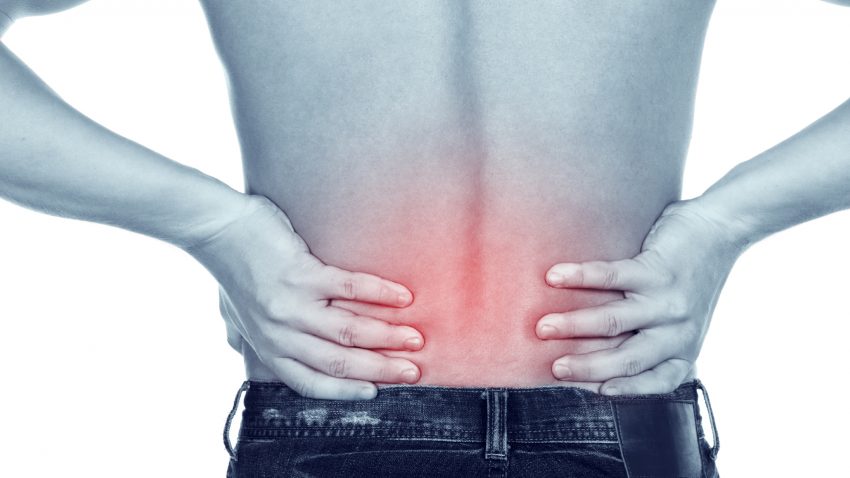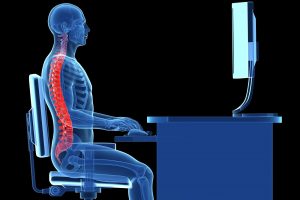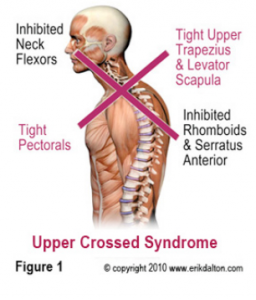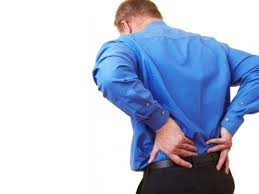

Upper & Lower Cross Syndrome: Symptoms, Causes, Treatment
The Causes and Symptoms
Prolonged sitting is a common occurrence in the majority of Americans’ lives today. From driving to studying, or office work to relaxing in front of the TV. As the prevalence of sitting has increased, the understanding of the negative effects on your health and well being has increased as well. Sitting is one of the worst “activities” that we can participate in. Why, you ask? Simply put, sitting causes changes in the ideal posture to facilitate proper function of the human body. Besides the obvious decrease in physical output, sitting also affects the body in two primary syndromes, or group of physical dysfunctions that lead to future issues. I will go into greater detail of each of these categories, the first being Upper Crossed Syndrome and the second being Lower Crossed Syndrome. One affects your head, neck, shoulders, upper back, and chest. The other affects your abdominals, pelvis, glutes, hip flexors, and hamstrings. These syndromes lead to headaches, shoulder pain, neck pain, decreased respiration, decreased pH balance, lower back pain, pelvic instability, and even sciatica.
Upper Crossed Syndrome
Upper Crossed Syndrome refers to a collection of hypertonic (chronically tight) muscles and inhibited (weak) muscles that cause that infamous poor posture with rounded shoulders, or “slumped” look we see all too often these days. Prolonged driving or computer work leads to the tightening of the SCM muscle, occipital muscles (which cause headaches), scalenes, upper trapezius, and pectoralis muscles. There is also weakening of the deep neck flexors, serratus anterior, and rhomboids. The combined postural changes caused by this altered muscle tone can often lead to tension headaches, neck pain, shoulder pain, thoracic outlet syndrome, numbness and tingling into the arms, mid back pain, and difficulty breathing. The chronically shallow breathing that can occur can then lead to a trend towards respiratory infections. The decrease of efficient off gassing of carbon dioxide can cause an acidifying of the pH balance of the body leading to other infections and excessive bacterial growth.
Lower Crossed Syndrome
Lower Crossed Syndrome pertains to muscles of the lower body as the name implies, such as the psoas muscle (hip flexor), which is in a shortened and thus tightened position whilst sitting. The erector spinae and transverse abdominus become deconditioned and weak. This is a problem, as these muscles help maintain stability of the lumbar spine. Loss of trunk stability can predispose one to injury of the lower back or even disc herniation. Deconditioning of the gluteus maximus and medius will cause both compensation of the hamstrings and also the piriformis muscle. Now, when the piriformis muscle is chronically hypertonic (tight), it can commonly irritate the sciatic nerve which runs in close proximity either behind or through the muscle.
The solution
If you are someone who sits frequently and for long periods of time, what can you do to counteract the negative effects of sitting? Simple activities judicially practiced throughout your day can be your best defense.
- Take regular breaks to walk around, stretch, and hydrate.
- Avoid forward head posture, keep your ears over your shoulders.
- Engage in vigorous physical activity everyday.
- Setting your work station properly. Monitor at eye level or slightly higher. Ankles, knees, hips, and back at approximately 90 degrees or requesting a standing desk to alternate working positions.
- Consult a professional if prolonged sitting has caused negative symptoms to arise. Symptoms are a sign that rises to the surface of an underlying condition.




